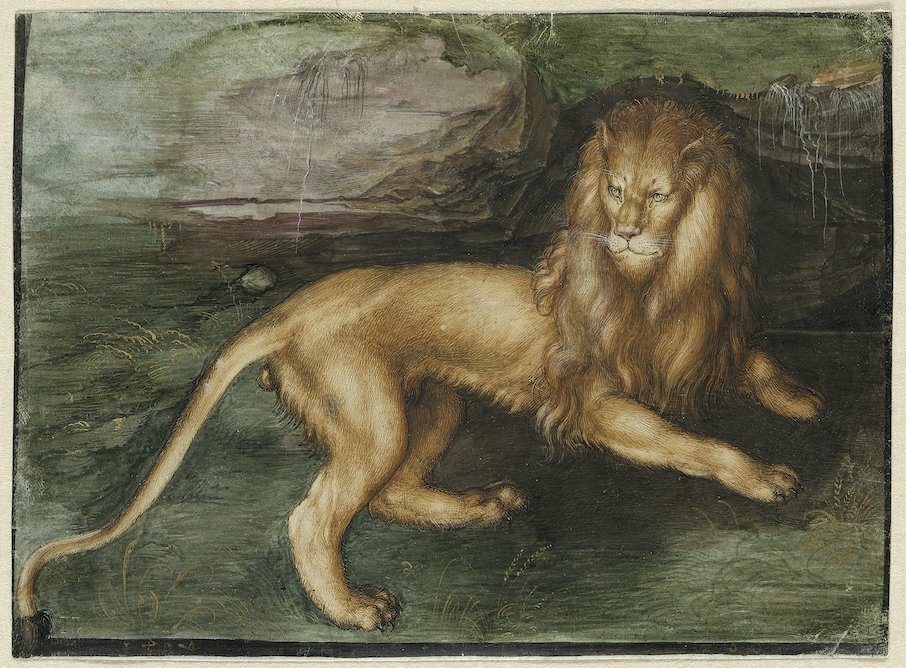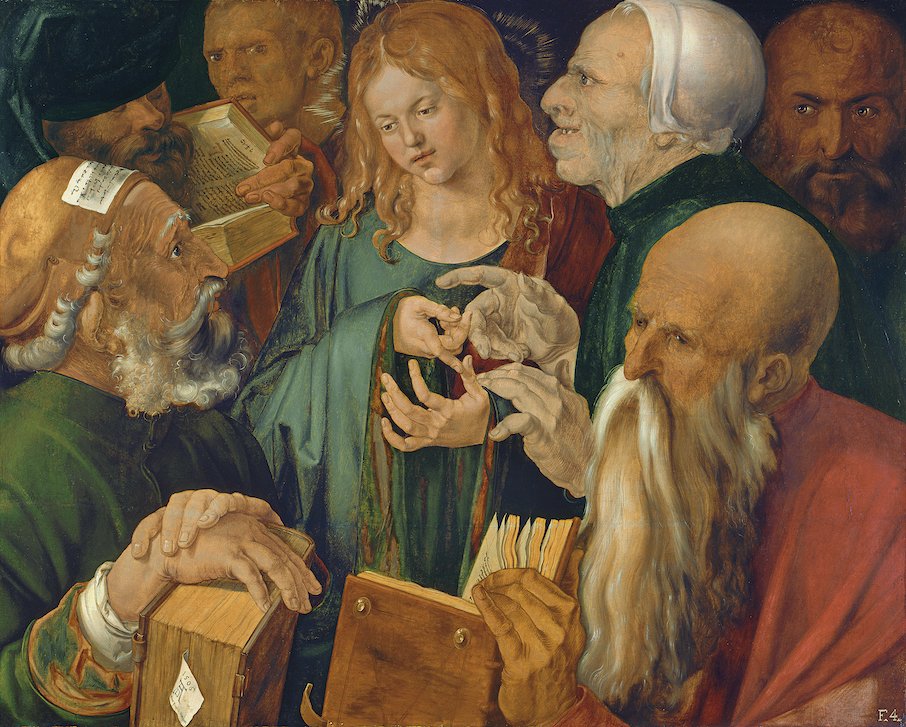A World of Marvels
Why is it that children and teenagers who love doing meticulous drawings revere Albrecht Dürer, whom they seem to discover by osmosis? Or what about his strokable Young Hare of 1502, so warm and heavy in its furry contentment that its nose twitches; or his dazzling 1498 self-portrait as a stylish 26-year-old, with hyper-realistic curling long hair.
Those two images are so widely known that it’s no lack that they’re not in the National Gallery’s new blockbuster, Dürer’s Journeys, which has 135 engravings, woodcuts, paintings, drawings, plus some rare diary and journal pages. More than 80 works are by the prolific German genius, others by contemporary Netherlandish masters such as Quinten Massys, Lucas van Leyden, Bernaert van Orley and Jan Gossaert. Most have never been shown here. There are numerous detail-filled engravings, such as St Eustace (c.1500), including wonderful animals with warm weighty bodies and feeling faces — from lions, horses and dogs to snuffling pigs, and even a red-bottomed baboon.
Albrecht Dürer: Saint Eustace. About 1499–1503. Engraving. Rijksmuseum, Amsterdam (RP-P-OB-1219) © Rijksmuseum, Amsterdam. (Detail of this image at top of page).
Dürer’s Journeys explores the artist’s extensive travels in Europe, focusing on a long journey from 1520-1521, which he recorded in detail. During this trip, along with his wife, Agnes, and their maid, he worked as well as being a tourist; made friends, and buttered up potential patron Margaret of Austria (and her entourage) to get a crucial pension reinstated. Dürer was well aware how fickle artists’ incomes can be. His journal notes what things cost and who did — or did not — pay him. His pension had stopped when his patron, Emperor Maximilian, died in 1519. He needed Maximilian’s successor Charles V to reinstate it, to secure what he presumably hoped would be a long old age (it wasn’t: he died at 57). During this trip he also sold, judiciously gave, and promoted his lucrative prints; fulfilled commissions including many portraits, and made sketches for future reference. Examples of all are on show.
Albrecht Dürer was that rare thing, a brilliant artist with corollary business acumen. So when he headed north in 1520, first to Aachen to the coronation of Charles V to make his pension plea, his fame preceded him. One of the reasons that so many of his works exist, apart from his output, is that they were collected during his lifetime and eagerly sought after his death. Handsome Dürer was a star.
Born in Nuremberg in 1471, one of 18 children to a Hungarian immigrant goldsmith father, the precocious boy learned goldsmithing, then painting and engraving. Nuremberg did not have the constraining guild system of other cities, so artists could work in several fields. He admired print-maker Martin Schongauer, whose detailed work influenced him, even down to a signature made of two initials, and tried to visit him in Colmar in 1492, travelling by boat, but Shongauer had died. In 1493, again by river, on what co-curator Susan Foister calls “the motorways of Dürer’s time”, he went to Strasbourg, then Basel, a book and print centre. There he made a woodcut book title page of St Jerome with a doglike, snouty lion.
Albrecht Dürer: Saint Jerome. From Epistolare beati Hieronymi, published by Nikolaus Kesler 1492. Woodcut. Syndics of Cambridge University Library (Peterborough D.11.1) [No pic available at time of writing, apols for slightly blurred photo by me]
He painted another lion around the same time — just a sketch, also perhaps not from life — but it still merited its own painting.
Albrecht Dürer: A Lion, 1494. Gouache on parchment, heightened with gold. Hamburger Kunsthalle, Kupferstichkabinett (23005). © Photo Scala, Florence/bpk, Bildagentur für Kunst, Kultur und Geschichte, Berlin / photo: Christoph Irrgang
He returned to St Jerome often, in 1514 producing an engraving both fascinating and ingenious. Who can resist the now life-like resting lion and dog in the foreground. Or the skill with which Dürer drew light coming in, or the timber of the joists?
Albrecht Dürer: St Jerome in his Study, 1514. Engraving on laid paper. Ashmolean Museum Oxford
His early technical ability in engraving meant he could draw flawless parallel lines so close that one almost needs a magnifying glass, and could render minute, endlessly varied details, whether roof tiles, windows, armour, hair, foliage, or animals, with equal facility. This exhibition proves that neither skill nor imagination ever waned. Nor did his eyesight and firmness of hand, even in his last known print (of Erasmus) two years before his death in 1528. Whatever size the final work, his technique was flawless; the burin rock-solid. It’s astounding.
Married in 1492, with his own workshop, Dürer set off in 1494-5 to Italy. Back in Nuremberg, he built up a flourishing career, painting and engraving, running a studio, helped by family members. Both his mother and sister sold prints for him at famous fairs. The remarkable St Eustace comes from this period — a virtuoso performance of saint and animals in scenery and landscape, every part animated by that relentlessly competent burin. Look closely around the dogs’ feet, note the perfect alignment of the burin’s marks and also where Dürer plays with it, drawing scallop patterns, or short scratches for the tufts of grass. He enjoyed himself. No one who is bored can draw like this; nor give each dog expression and character. A special part of Dürer’s allure is that everything seems alive; there are very few straight lines.
Albrecht Dürer: Burkhard of Speyer 1506 Oil on panel. Lent by Her Majesty The Queen. Royal Collection Trust / © Her Majesty Queen Elizabeth II 2021
Albrecht Dürer: Christ among the Doctors 1506. Oil on panel. Museo Nacional Thyssen-Bornemisza, Madrid. © Copyright Museo Thyssen-Bornemisza, Madrid
When he set off to Italy again for two years in 1505, he observed Venetian portraiture and produced his own. A fast learner, he absorbed what would serve him. In his Burkhard of Speyer, 1506, [above] he meshed what he’d seen with his brilliance at fur and hair, adding a sideways glance that transmits intelligence. Also from 1506, Christ Among the Doctors, [above] a rare large painting, shows the direction the artist might easily have taken if printmaking hadn’t proved more lucrative.
Others collected, and copied his work, which the exhibition demonstrates. His print of Adam and Eve is set beside an almost direct painted copy – bar altered heads and the removal of Dürer’s enchanting animals – by Jan Gossaert, even down to conveniently acrobatic fig leaves that fly on springy twigs slap across the lovers’ genitals.
Albrecht Dürer: Adam and Eve 1504. Engraving. Rijksmuseum, Amsterdam (RP-P-OB-1155) © Rijksmuseum, Amsterdam
Jan Gossaert: Adam and Eve about 1507–8. Oil on panel. Museo Nacional Thyssen-Bornemisza, Madrid © Copyright Museo Thyssen-Bornemisza, Madrid
Dürer continued in his Nuremberg studio before the great 1520 trip spurred by the need for his pension. Margaret of Austria secured it with her nephew, Charles V. But to Dürer’s annoyance she didn’t buy anything from him. Her 1518 portrait by Bernaert van Orley shows someone sharp as a tack as well as handsome.
Bernaert van Orley: Portrait of Margaret of Austria about 1518. Oil on wood. The Royal Monastery of Brou, Bourg-en-Bresse © Hugo Maertens
From Aachen, Dürer went to Antwerp, then Cologne, Bruges, Ghent. He worked prodigiously, sketched in a prepared metal-point notebook; wrote in his journal. When did he sleep? Using all the techniques in which he excelled, from charcoal to chalk to engraving to silverpoint and sometimes to painting, he made, alongside paying portraits, studies of clothing (like Young Woman in Netherlandish Dress) and of ordinary people. In Brussels, lured to the zoo by the big cats he liked, he drew a sheet of animals, coloured for extra effect. A red bottomed baboon clearly took his fancy. And unlike that rather heraldic lion in gouache on parchment in his early twenties (when he may not have yet seen the real thing), these are real sleep-heavy cats, with one enjoying a good mane-shake on waking.
Albrecht Dürer: Young Woman in Netherlandish Dress 1521. Brush and brown and white ink on grey-violet prepared paper. National Gallery of Art, Washington Widener Collection 1942. Image courtesy of the Board of Trustees National Gallery of Art Washington DC
Albrecht Dürer: Sketches of Animals and Landscapes 1521. Pen and black ink, and blue, grey, and rose wash on paper. Sterling and Francine Clark Art Institute, Williamstown, Massachusetts, USA. © Sterling and Francine Clark Art Institute, Williamstown, Massachusetts, USA
There was nothing Albrecht Dürer could not tackle, and thanks to his awareness of his genius as well as his fame, we gain this remarkable insight into the world he lived in. This stimulating and revealing show is as important as Tutankhamen near half a century ago, in 1972, when people queued round the block to get in.
If you find yourself at a loss to entertain bright young relatives around Christmas, take them to this, then give them a drawing pad, and see what happens.
The Credit Suisse Exhibition
DURER’S JOURNEYS: Travels of a Renaissance Artist
National Gallery, London, 20 November - 27 February 2022.
https://www.nationalgallery.org.uk/
No images may be taken from this blog or used in any way












